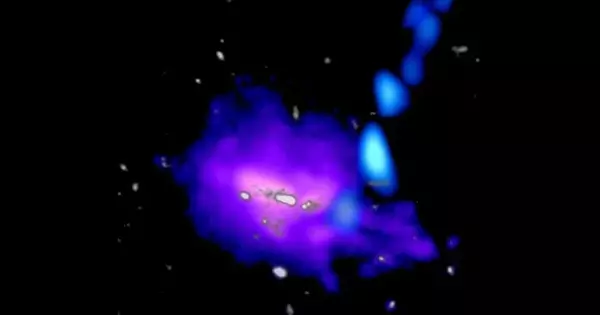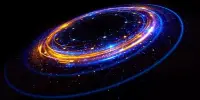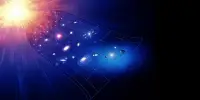Neutron stars are extremely dense objects formed when a massive star exhausts its fuel and collapses in on itself. They are so dense that a teaspoon of neutron star material weighs the same as a mountain on Earth.
The ‘disk winds’ associated with the accretion disk around Hercules X-1, a system in which a neutron star draws material away from a sun-like star, have been mapped by astronomers. The findings could help explain how supermassive black holes shape entire galaxies.
An accretion disk is a massive whirlpool of gas and dust that gathers like cotton candy around a black hole or neutron star as it draws material from a nearby star. The spinning disk creates powerful winds that push and pull on the sprawling, rotating plasma. These massive outflows have the potential to heat and blow away the gas and dust that surrounds black holes.
At very large scales, “disk winds” can reveal how supermassive black holes shape entire galaxies. Disk winds have been observed in a variety of systems, including accreting black holes and neutron stars. However, they have only ever seen a very limited view of this phenomenon.
MIT astronomers have now observed a wider swath of winds in Hercules X-1, a system in which a neutron star draws material away from a sun-like star. The accretion disk of this neutron star is unusual in that it wobbles, or “precesses,” as it rotates. Using this wobble, the astronomers were able to capture different perspectives of the rotating disk and create a two-dimensional map of its winds for the first time.
In the future, we could map disk winds in a variety of objects and determine how wind properties change, for example, with a black hole’s mass or the amount of material it is accreting. That will help determine how black holes and neutron stars influence our universe.
Peter Kosec
The new map shows the wind’s vertical shape and structure, as well as its velocity – hundreds of kilometers per second, or about a million miles per hour, which is at the lower end of what accretion disks can spin up. If astronomers can detect more wobbly systems in the future, the mapping technique developed by the team could aid in understanding how disk winds influence the formation and evolution of stellar systems, and even entire galaxies.
“In the future, we could map disk winds in a variety of objects and determine how wind properties change, for example, with a black hole’s mass or the amount of material it is accreting,” says Peter Kosec, a postdoc at MIT’s Kavli Institute for Astrophysics and Space Research. “That will help determine how black holes and neutron stars influence our universe.”
Kosec is the lead author of a study appearing in Nature Astronomy. His MIT co-authors include Erin Kara, Daniele Rogantini, and Claude Canizares, along with collaborators from multiple institutions, including the Institute of Astronomy in Cambridge, U.K.

Fixed sight
Disk winds have most frequently been observed in X-ray binaries, which are systems in which a black hole or neutron star pulls matter from a less dense object, resulting in a white-hot disk of inspiraling matter and outflowing wind. It is unclear how winds are launched from these systems. According to some theories, magnetic fields could shred the disk and expel some of the material as wind. Others believe that neutron star radiation can heat and evaporate the disk’s surface in white-hot gusts.
Although the shape and extent of disk winds have been difficult to resolve, clues to their origins can be deduced from their structure. Most binaries generate accretion disks with relatively even shapes, like thin donuts of gas spinning in a single plane. Astronomers studying these disks from afar can only see the effects of disk winds within a fixed and narrow range, relative to their rotating disk. Any wind detected by astronomers is thus a small sliver of its larger structure.
“We can only probe the wind properties at a single point, and we’re completely blind to everything around that point,” Kosec notes.
In 2020, he and his colleagues realized that a single binary system could provide a more comprehensive view of disk winds. Hercules X-1 has distinguished itself from other known X-ray binaries by having a warped accretion disk that wobbles as it rotates around the system’s central neutron star.
“The disk is really wobbling over time every 35 days, and the winds are originating somewhere in the disk and crossing our line of sight at different heights above the disk with time,” Kosec says. “That’s a very unique property of this system that helps us understand its vertical wind properties.”
A warped wobble
In the new study, the researchers observed Hercules X-1 using two X-ray telescopes – the European Space Agency’s XMM Newton and NASA’s Chandra Observatory.
“What we measure is an X-ray spectrum, which means the amount of X-ray photons that arrive at our detectors, versus their energy. We measure the absorption lines, or the lack of X-ray light at very specific energies,” Kosec says. “From the ratio of how strong the different lines are, we can determine the temperature, velocity, and the amount of plasma within the disk wind.”
Astronomers were able to see the line of the warped disk moving up and down as it wobbled and rotated, similar to how a warped record appears to oscillate when viewed from the edge. The effect was such that the researchers could see evidence of disk winds at varying heights relative to the disk rather than at a single, fixed height above a uniformly rotating disk.
The researchers were able to scan properties such as the temperature and density of winds at various heights with respect to the disk and construct a two-dimensional map of the wind’s vertical structure by measuring X-ray emissions and absorption lines as the disk wobbled and rotated over time.
“What we see is that the wind rises from the disk, at an angle of about 12 degrees with respect to the disk as it expands in space,” says Kosec. “It’s also getting colder, clumpier, and weaker at higher altitudes above the disk.”
The researchers intend to compare their findings to theoretical simulations of various wind-launching mechanisms to see which can best explain the origins of the wind. They hope to discover more warped and wobbly systems and map their disk wind structures in the future. Then, scientists would have a better understanding of disk winds and how such outflows affect their surroundings, especially at much larger scales.
















